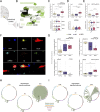Molecular hallmarks of excitatory and inhibitory neuronal resilience to Alzheimer's disease
- PMID: 41035073
- PMCID: PMC12487324
- DOI: 10.1186/s13024-025-00892-3
Molecular hallmarks of excitatory and inhibitory neuronal resilience to Alzheimer's disease
Abstract
Background: A significant proportion of individuals maintain cognition despite extensive Alzheimer's disease (AD) pathology, known as cognitive resilience. Understanding the molecular mechanisms that protect these individuals could reveal therapeutic targets for AD.
Methods: This study defines molecular and cellular signatures of cognitive resilience by integrating bulk RNA and single-cell transcriptomic data with genetics across multiple brain regions. We analyzed data from the Religious Order Study and the Rush Memory and Aging Project (ROSMAP), including bulk RNA sequencing (n = 631 individuals) and multiregional single-nucleus RNA sequencing (n = 48 individuals). Subjects were categorized into AD, resilient, and control based on β-amyloid and tau pathology, and cognitive status. We identified and prioritized protected cell populations using whole-genome sequencing-derived genetic variants, transcriptomic profiling, and cellular composition.
Results: Transcriptomics and polygenic risk analysis position resilience as an intermediate AD state. Only GFAP and KLF4 expression distinguished resilience from controls at tissue level, whereas differential expression of genes involved in nucleic acid metabolism and signaling differentiated AD and resilient brains. At the cellular level, resilience was characterized by broad downregulation of LINGO1 expression and reorganization of chaperone pathways, specifically downregulation of Hsp90 and upregulation of Hsp40, Hsp70, and Hsp110 families in excitatory neurons. MEF2C, ATP8B1, and RELN emerged as key markers of resilient neurons. Excitatory neuronal subtypes in the entorhinal cortex (ATP8B+ and MEF2Chigh) exhibited unique resilience signaling through activation of neurotrophin (BDNF-NTRK2, modulated by LINGO1) and angiopoietin (ANGPT2-TEK) pathways. MEF2C+ inhibitory neurons were over-represented in resilient brains, and the expression of genes associated with rare genetic variants revealed vulnerable somatostatin (SST) cortical interneurons that survive in AD resilience. The maintenance of excitatory-inhibitory balance emerges as a key characteristic of resilience.
Conclusions: We have defined molecular and cellular hallmarks of cognitive resilience, an intermediate state in the AD continuum. Resilience mechanisms include preserved neuronal function, balanced network activity, and activation of neurotrophic survival signaling. Specific excitatory neuronal populations appear to play a central role in mediating cognitive resilience, while a subset of vulnerable interneurons likely provides compensation against AD-associated hyperexcitability. This study offers a framework to leverage natural protective mechanisms to mitigate neurodegeneration and preserve cognition in AD.
Keywords: Alzheimer’s disease; Cognitive reserve; Cognitive resilience; E/I imbalance; Gene expression; Genetics; Rare variants; SST interneurons; Single-cell RNA sequencing; Transcriptomics; Vulnerability.
© 2025. The Author(s).
Conflict of interest statement
Declarations. Ethics approval and consent to participate: Detailed information regarding ethical approval and consent for the bulk RNAseq data [31, 32], snRNAseq data [19, 47], and whole-genome data [57] has previously been described. ROSMAP studies were approved by the Institutional Review Board of Rush University Medical Center. Whole genome sequencing studies were approved by the Institutional Review Board from Massachusetts General Hospital (protocols 2015P000111 and 2019P001879).Human brain tissue used for immunostaining experiments, collected at Beth Israel Deaconess Medical Center (BIDMC), was approved by the BIDMC Institutional Review Board (IRB Protocol 2023P000848). Consent for publication: Not applicable. Competing interests: Authors declare that they have no competing interests.
Figures





Update of
-
Molecular hallmarks of excitatory and inhibitory neuronal resilience and resistance to Alzheimer's disease.bioRxiv [Preprint]. 2025 Jan 15:2025.01.13.632801. doi: 10.1101/2025.01.13.632801. bioRxiv. 2025. Update in: Mol Neurodegener. 2025 Oct 1;20(1):103. doi: 10.1186/s13024-025-00892-3. PMID: 39868232 Free PMC article. Updated. Preprint.
References
MeSH terms
Substances
Grants and funding
- P30 AG072975/AG/NIA NIH HHS/United States
- U01 AG061356/AG/NIA NIH HHS/United States
- R01 AG017917/AG/NIA NIH HHS/United States
- RF1 AG062377/AG/NIA NIH HHS/United States
- R01 AG014713/AG/NIA NIH HHS/United States
- AARF-23-1148927/ALZ/Alzheimer's Association/United States
- P30 AG010161/AG/NIA NIH HHS/United States
- R01AG048080/AG/NIA NIH HHS/United States
- R01 AG081017/AG/NIA NIH HHS/United States
- R01AG058002/AG/NIA NIH HHS/United States
- U01 NS110453/NS/NINDS NIH HHS/United States
- R01AG074003/AG/NIA NIH HHS/United States
- RF1 AG054012/AG/NIA NIH HHS/United States
- U01 AG046152/AG/NIA NIH HHS/United States
- R01 AG058002/AG/NIA NIH HHS/United States
- R01AG014713/AG/NIA NIH HHS/United States
- R01AG054012/AG/NIA NIH HHS/United States
- U01NS110453/AG/NIA NIH HHS/United States
- U01AG46152/AG/NIA NIH HHS/United States
- RF1 AG048080/AG/NIA NIH HHS/United States
- R01 AG082093/AG/NIA NIH HHS/United States
- P30AG10161/AG/NIA NIH HHS/United States
- U19AG073172/AG/NIA NIH HHS/United States
- P30AG72975/AG/NIA NIH HHS/United States
- R01AG15819/AG/NIA NIH HHS/United States
- R01AG081017/AG/NIA NIH HHS/United States
- R01 AG074003/AG/NIA NIH HHS/United States
- RF1AG062377/AG/NIA NIH HHS/United States
- RF1AG054321/AG/NIA NIH HHS/United States
- R01AG082093/AG/NIA NIH HHS/United States
- RF1 AG054321/AG/NIA NIH HHS/United States
- U19 AG073172/AG/NIA NIH HHS/United States
- R01AG062547/AG/NIA NIH HHS/United States
- R01AG17917/AG/NIA NIH HHS/United States
- U01AG61356/AG/NIA NIH HHS/United States
- R01 AG062335/AG/NIA NIH HHS/United States
- R01 AG062547/AG/NIA NIH HHS/United States
- R01AG062335/AG/NIA NIH HHS/United States
- R01 AG015819/AG/NIA NIH HHS/United States
LinkOut - more resources
Full Text Sources
Medical
Miscellaneous

